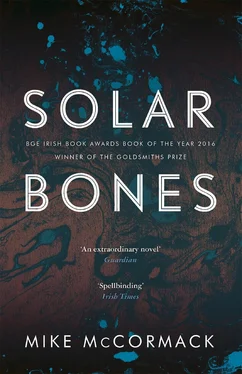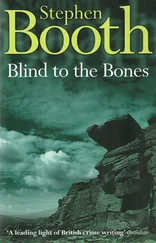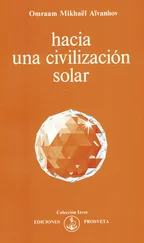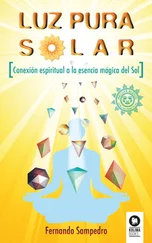my own favourite
a young hermit who, towards the end of the last millennium, took up residence in a ruined bothán on the side of a hill not ten miles from here, a young woman who, by way of some ancient rite, was professed a hermit by the Vatican with licence to beg and preach among these rainy hills, claiming that God had called her to go deeper into the desert so that she could be more aware of his presence in greater silence and solitude but who, after a few years living the full sacramental life on the mountains of West Mayo with nothing to distract the eye or hand save damp sheep and stone walls, came forth with her message to the world, telling us that
hell is real and it’s not empty
simple and blunt as that
hell is real and it’s not empty
she said, the sum total of everything she had gleaned from all her years of prayer and penance, her savage epistle with no mention in it anywhere of the redeemer having passed this way on his mission of mercy or forgiveness and
this is how you get carried away
sitting here in this kitchen
carried away on an old theme, swept up on a rush of words and associations strewn out across the length and breadth of this county, a hail of images surging through me while at the bottom of the page another story of how
a large, abandoned industrial facility in the north of the county is being assessed as a possible site for an asbestos conversion plant which will form part of a massive toxic dump to process industrial and medical waste from the rest of the province in a state-of-the-art incineration process which, if economic studies and environmental assessments prove favourable, could come online in a few years’ time with the promise of jobs and subsidiary investment across the county and
something out of the past
a psychic link which dates back to my childhood when
my father worked on its construction
he fucking did
worked on it at a time when, with a similar promise of prosperity, it was spoken of as if it were a cathedral or a temple that was being built on that raised site above the small town of Killala, such a beacon of industrial progress that for the two years of its construction I would watch my father pack his bags every Sunday evening for the week ahead and when seven o’clock came he would kiss my mother and sister goodbye and walk up to the top of the road where he would be picked up by a minibus full of other men from around the parish, tradesmen and labourers, men who would spend a full two years concreting and block-laying and steel-fixing this massive facility into existence which, when fully operational, would employ three hundred and fifty men and women in the manufacture of acrylic yarn and fibre, an end purpose which initially disappointed me as it seemed such a puny thing considering all the hope and effort invested in it, unworthy in every way, until I learned that the manufacturing process would utilise a highly toxic compound called acrylonitrile, a chemical that would have to be transported overland in the middle of the night under security escort, shipped in double-hulled, crash-proof containers, a vivid circumstance suffused with enough danger to recast the whole project in a more credible apocalyptic glow so that it now appeared, to my refired imagination, a pioneering enterprise which called for fearless, heroic men like my father whom
I would accompany every Sunday evening to the top of the road to watch him head off in that minibus and every time feel his leaving so keenly it was as if a part of myself was going off to work on that distant project so that in this way, my own father working on this facility, it was readily established in my young mind that I too was heroic and courageous and possibly cut out for some notable destiny, all this just twenty years before the facility would cease production entirely, the last of the dirty industries in this part of the world, the whole enterprise succumbing to a convergence of adverse factors — oil rising through fifty dollars a barrel and the world’s turn to natural fabrics principal among them — till the day came when it stood empty and dilapidated on a shallow plateau above the town of Killala — the last shipment of yarn gone through the gates, the workers paid off and the lights turned out — a monumental example of industrial gothic corroding in the winds which blew in from the Atlantic, an empty facility fully serviced with state-of-the-art utilities — road, rail, water and electricity — but which no one would touch because the whole thing was sheathed in asbestos, walls, roofs and ceilings, acres of it and with a projected cost of dismantling it in accordance with EU environmental code calculated to run close to ten million euro, it was decided that its owners, the county council, would leave it there to fuck and not disturb it in any way lest it shed its lung-corroding fibre over the whole of North Mayo
Crossmolina, Ballina, Attymass and
west into the badlands of Ballycroy and Mulranny
the terra damnata of Shanamanragh
the land that time forgot but
well known to us as it’s
near Mairead’s home place and we have driven there many times, particularly so in the early years of our marriage when Agnes and Darragh were young and we would take them to visit their grandparents for their summer holidays, pack them into the car and drive north, the journey itself about sixty miles but one which crossed into terrain so different to this part of the world a few miles north of the small village of Mulranny at precisely that point where the N59 twists its way under a single-arch stone bridge set among blazing rhododendrons, the bridge always marked for me that complete change of terrain from the hills and drumlins of South Mayo to the open and more desolate expanses of the north, this bridge always affected something deep in me because every time I passed beneath it, with Mairead beside me and the kids in the back, I would experience that subtle shift within me which I always imagined was my soul flinching in the landscape that opened up beyond that bridge, where, within a few miles and with a sudden thinning of the light the mountains withdrew into the clouded distance and the world levelled down to that open bogland through which the road wended its way towards Ballycroy and Bangor and out onto Doohoma Head where Mairead’s parents lived on a small farm which had come down on her mother’s side and where Darragh and Agnes would run wild through the fields of hay and tillage which stretched in a neat stripe from the gable of the house to the shore for a couple of weeks of every summer and
this is how you get carried away again
in memory of
swept up in that sort of reverie which has only a tangential connection to what you were thinking of, in this case the collapse of our banking system and the economy, a collapse so sudden and comprehensive that one year later it still threatens to have a domino effect across several linked economies, fully capable of undermining banking systems across Germany and France, not to mention crippling our neighbour’s export trade to this country, the collapse of a small bank in an island economy becoming the fault line through which the whole universe drains, the whole thing ridiculously improbable, so unlikely in scale and consequence it’s as if
something that never was has finally collapsed
or revealed itself to be constructed of air before eventually
falling to ruin in that specific way which proved it never existed even if all around us now there is that feeling of something massive and consequential having come asunder, as when certain pressures exceeded critical thresholds to admit that smidgen of chaos which brings the whole thing down around itself so that even if we believe this collapse is essentially in some adjacent realm there is no denying the gravitational pull we feel in everything around us now, the instability which thrills everywhere like a fever, so tangible you have to wonder
Читать дальше












